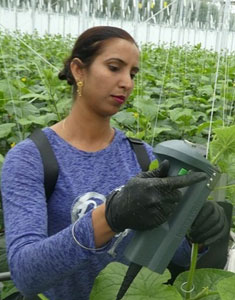Sign up here to subscribe to the Grower2grower Ezine. Every two weeks you will receive new articles, specific to the protected cropping industry, informing you of industry news and events straight to your inbox.
Mar 2024
High hygiene standards are crucial to mitigate co-infection

No silver bullet to mitigate co-infection with the ToBRFV virus.
Pepino mosaic virus (PepMV) is present in many tomato-producing countries, while the relatively new tomato brown rough fruit virus (ToBRFV) is becoming more widespread. It is therefore possible for tomatoes to be infected with PepMV, ToBRFV, or a combination of both. It is therefore important to understand the best way to protect plants and to observe whether the order of infection with the virus creates differences in symptoms or expression. This article explains the mechanisms underlying infection by different viruses.

What does a virus do in plant cells: virus multiplication
Viruses are made up of genetic material – deoxyribonucleic acid (DNA) or ribonucleic acid (RNA) – a protein envelope, which protects the DNA or RNA, and a movement protein that helps the body move through the plant. The multiplication of the DNA (or RNA) of the virus is actually carried out by the plant’s cells.
When the virus enters the cell, the plant reads its DNA or RNA and begins to multiply it, causing the virus to replicate. As RNA is duplicated, the cell begins to make protein envelopes and motion proteins. Once this has happened, a new, viable virus has been created and can move to the next plant cell, repeating the same process. There will be many copies of the virus in each cell, which will increase the amount of virus in the plant, which constitutes the infection.

Secondary virus infections
When plants are infected with a second virus, this new virus can also multiply rapidly in the plant. Replication of the second virus may be exacerbated by the first virus, as some proteins essential for infection with the new virus are already in the plant because of the first virus. For example, the movement proteins of the first virus can be used by the new virus to move around the plant.
Viruses can have different effects on each other, and these effects are not always the same. There are three different types of interactions that can occur between two viruses:
1. Synergy: The two viruses help each other and the symptoms of both viruses are stronger.
2. Antagonism: one of the viruses becomes predominant and the effects of the other are reduced.
3. Neither virus affects the other.
In some cases, ToBRFV is detected together with other viruses such as PepMV, Tomato Bronzing Disease Virus (TSWV), Tomato Mosaic Virus (ToMV), etc. It has been observed that symptoms on leaves may be more pronounced when ToBRFV infection is followed by PepMV infection. This is probably applicable to other viruses such as TSWV or tomato spoon yellow leaf virus (TYLCV).
For all of these viruses, it is unclear whether these more pronounced symptoms are a true synergy or whether they are due to other stressors, such as a suboptimal growing environment for the plant.
ToBRFV can be easily diagnosed, but even when ToBRFV is detected, we will still need to look for other viruses present in the plant, as they may be causing some or all of the visible symptoms.

Bayer Tests Single ToBRFV Infection and ToBRFV Infection in Combination with PepMV
As mentioned above, there are potentially many combinations of infection, whether it is ToBRFV – PepMV or vice versa or even tri-infection with TYLCV. Through our observations and technical discussions with our customers, Bayer evaluates new tomato varieties in two ways that best reflect real-world conditions and growers’ common practices: with a single ToBRFV infection and with a controlled PepMV* infection followed by a ToBRFV infection, described here as a co-infection.
*PepMV is introduced through vaccination.
In these trials, inoculation with ToBRFV is carried out at an early stage, a few weeks after planting. In our experience, young plants are highly susceptible to ToBRFV, as the virus multiplies rapidly and produces visible, but not extreme, symptoms. There do not appear to be differences between symptoms caused by a single ToBRFV infection or by a ToBRFV infection after PepMV vaccination. The brown spots and rings are most likely due to ToBRFV.
This suggests that the young plants are actively and very quickly, so the virus is also increasing and reaching high levels very quickly.
No silver bullet to mitigate co-infection with the ToBRFV virus
Co-infection with aggressive viruses is a major challenge, as any uncontrolled infection will reduce yields. Growers will need to adopt and maintain high levels of hygiene practices to maximize the number of productive plants and minimize ToBRFV infections until the end of the crop cycle.
Article Source: Co-infection with tomato brown rough fruit virus (ToBRFV) and Pepino mosaic virus (PepMV) (bayer.com) Read more articles related to ToBRFV on this site. It is infomative and important New Zealand growers are prepared if ToBRFV enters NZ.
CLASSIFIED
Photo
Gallery
Subscribe to our E-Zine
More
From This Category
Vegetables by Bayer – ToBRFV Knowledge Centre

MPI – decision to temporarily suspend all Imported Australian fresh Tomatoes the correct one.

Tomato Brown Rugose Fruit Virus (ToBRFV) confirmed in Australia – what we need to know
Jasper Verhoeven – Best Hygiene Practices for Greenhouses, A Dutch perspective

We have news. Reelenz has new owners.
























































